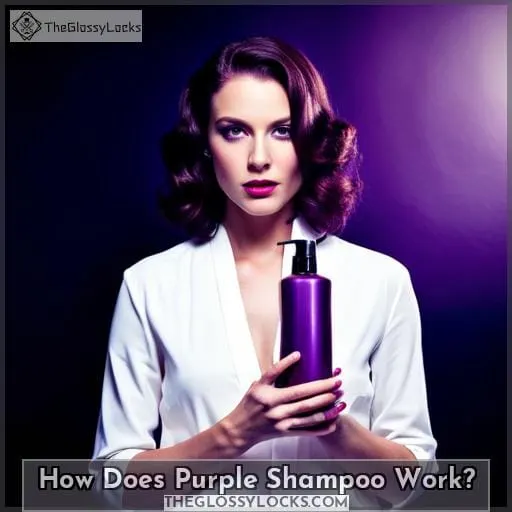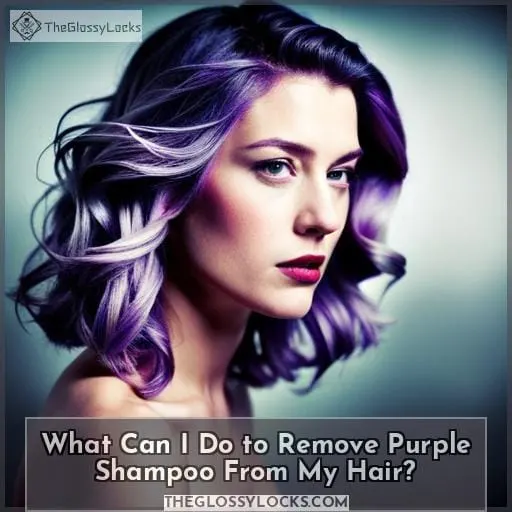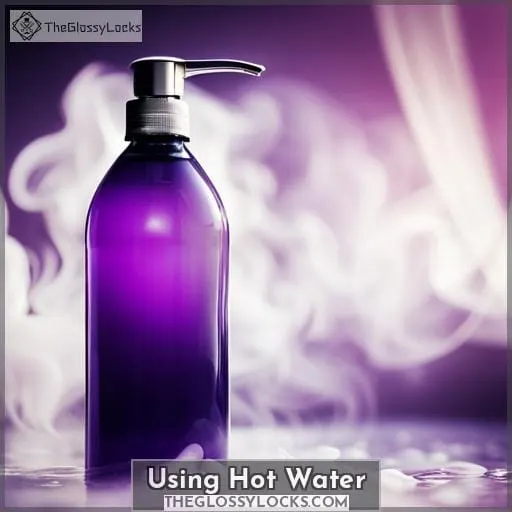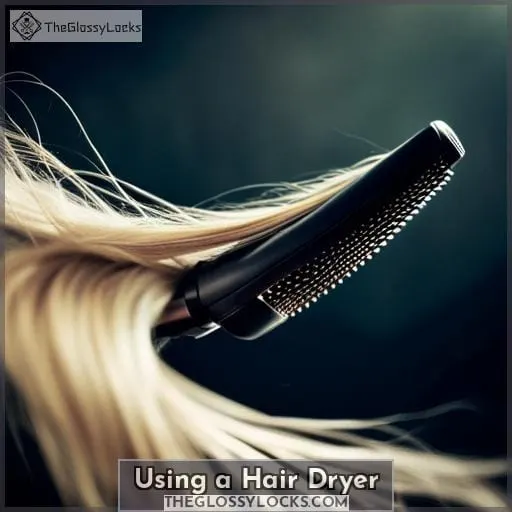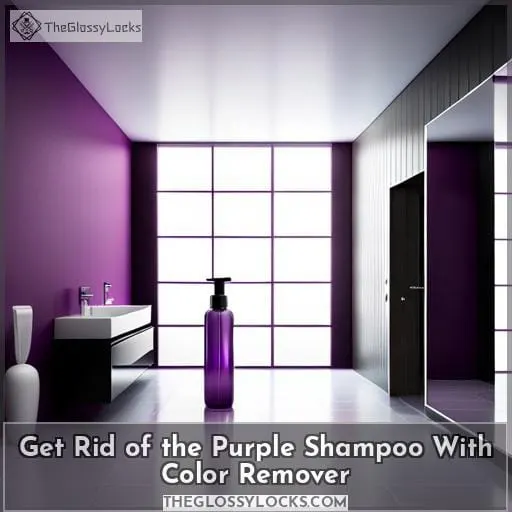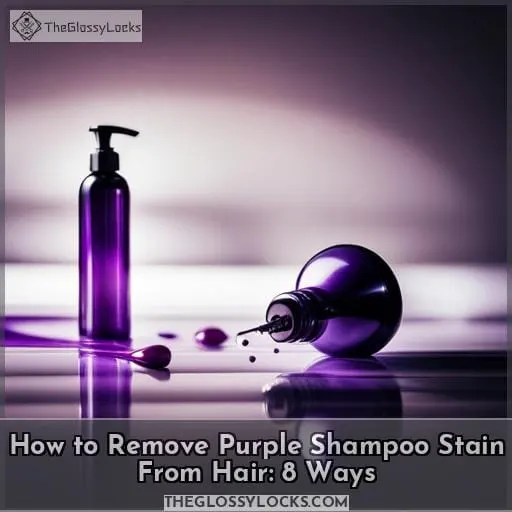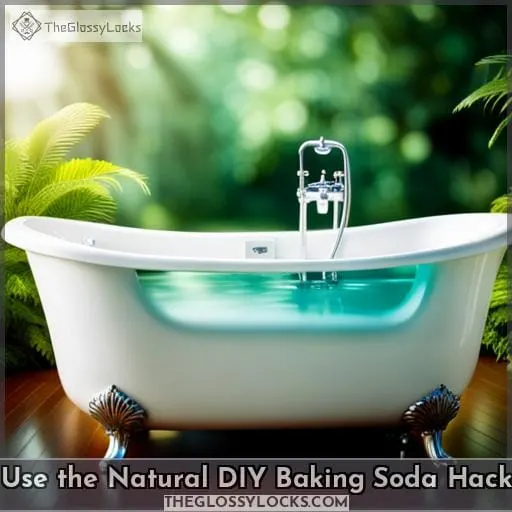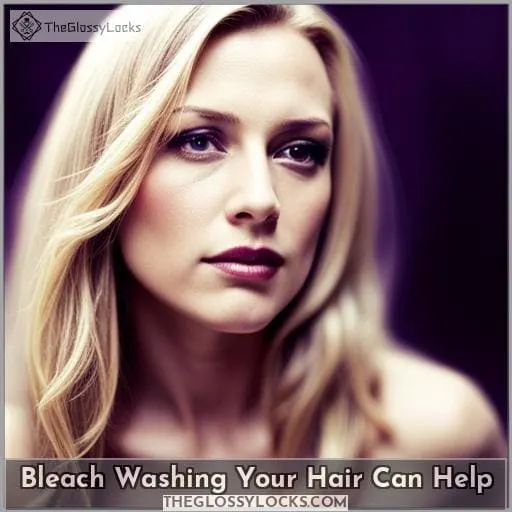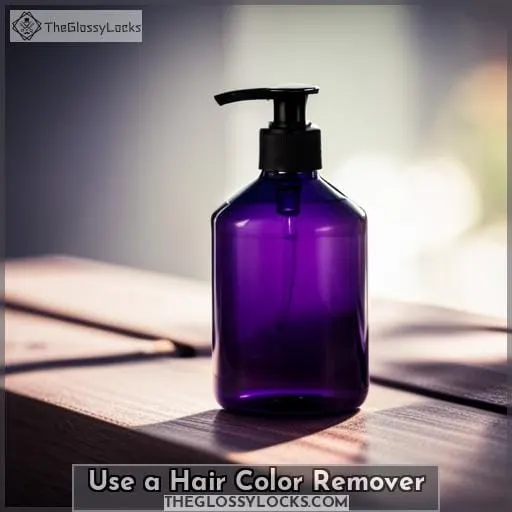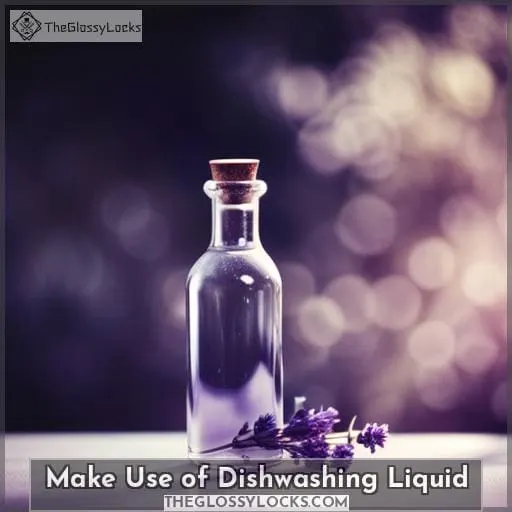This site is supported by our readers. We may earn a commission, at no cost to you, if you purchase through links.
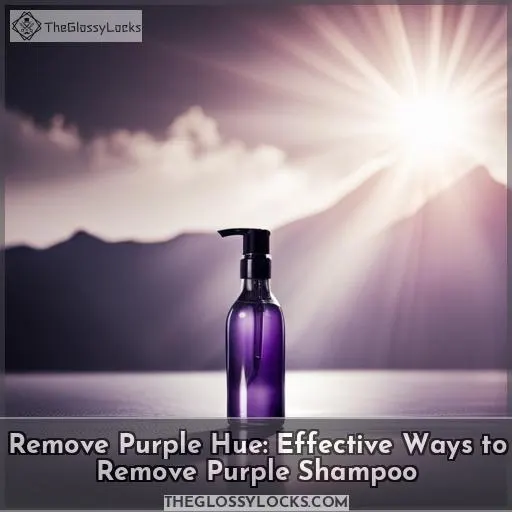
In this article, we’ll discuss how to effectively remove the unwanted color from your hair without damaging it further or having to resort to drastic measures like bleaching or dying your hair anew.
Table Of Contents
- Key Takeaways
- How Does Purple Shampoo Work?
- What Can I Do to Remove Purple Shampoo From My Hair?
- Using Hot Water
- Using a Hair Dryer
- Get Rid of the Purple Shampoo With Color Remover
- How to Remove Purple Shampoo Stain From Hair: 8 Ways
- Use the Natural DIY Baking Soda Hack
- Bleach Washing Your Hair Can Help
- Use a Hair Color Remover
- Make Use of Dishwashing Liquid
- Conclusion
Key Takeaways
- Use sulfate-free shampoo or dandruff shampoo to lift stubborn purple pigments.
- Apply low heat or use a hairdryer to release trapped pigments.
- Mix lemon juice with dish soap or use dishwashing liquid with lemon juice to lift the purple hue.
- Consider using a hair color remover or bleach washing for serious stain removal.
How Does Purple Shampoo Work?
Purple shampoo works by neutralizing yellow tones in blonde or light hair. It should be used sparingly to avoid a lasting tint. It’s important to maintain your color by using the right products for your hair type.
Purple shampoos have their benefits, but there are also some myths surrounding them. Don’t believe everything you hear! Choose a good quality shampoo with natural ingredients that won’t strip your locks of essential oils.
Be mindful of how often you use purple shampoo, as overdoing it can result in an unwanted hue on your mane, even if it’s only temporary. To remove any remaining stains after deep cleansing sessions, use sulfate-free shampoos.
Follow it up with heat styling tools carefully set at lower temperatures. This will prevent damage to delicate strands while releasing trapped pigments left behind from purple toning treatments.
If all else fails, look into color remover solutions. But make sure to follow instructions closely before applying!
What Can I Do to Remove Purple Shampoo From My Hair?
If you want to remove the purple hue from your hair caused by purple shampoo, there are several things you can try. Clarifying shampoos work well for removing buildup and excess pigments, while baking soda mixed with regular shampoo helps to neutralize the color.
Applying lemon juice combined with dish soap is another option that works on stubborn stains, as does using a sulfate-based shampoo or applying heat safely to release trapped pigments. Taking these steps will help restore your hair’s natural color without damaging it too much.
Use Clarifying Shampoo
Combat purple tint: Use clarifying shampoo monthly or twice a month to strip away product buildup. Baking soda, lemon juice, and sulfate shampoo tips help remove residue. Heat application safety must be followed when using color remover as a last resort.
Try Baking Soda
To effectively neutralize yellow tones, try baking soda in regular shampoo. Benefits include quick stain removal with lemon juice tricks and safe heat application.
Apply Lemon Juice
Mix lemon juice with dish soap to help break up the purple hue from your hair, and don’t forget that every cloud has a silver lining! Applying this DIY alternative helps restore pH balance, correcting hair discoloration.
Natural remedies like lemon juice benefit more than just removing stubborn stains—it can also provide overall shine and health benefits for your tresses. Whether you’re trying to remove purple shampoo stains or other product residues, applying lemon juice should be part of the process if you want long-term color correction results.
Use a Sulfate Shampoo
Try using a sulfate shampoo to effectively tackle any stubborn purple pigments. It can prevent fading and remove hair product buildup, leaving your locks looking vibrant and glossy.
Use Heat to Remove the Purple Hue
Applying low heat to your hair may help release trapped pigments, allowing you to reduce the purple hue. Heat application can be a great alternative for those who want to avoid overly relying on purple shampoo.
To prevent staining, use only a small amount of product and take care when applying it in order to maintain healthy hair color maintenance.
Using Hot Water
Be careful with hot water, as it can quickly scorch your hair like a desert in summertime. To use hot water to remove the purple hue from purple shampoo, start by setting the temperature to lukewarm and slowly increase it as you rinse.
Apply heat through steam or the direct flow of warm water until the desired color is achieved. Make sure not to overuse this method; otherwise, you may have to resort back to using a harsher chemical-based product, such as a color remover, for more stubborn stains.
During all steps when applying heat, whether from blow drying or styling tools, exercise precautionary measures. This will prevent damage from occurring on fragile strands of hair due to poor handling techniques, such as excessive heating without protective products like thermal sprays or serums applied beforehand.
By using these methods regularly, you can reduce the number of times you need to reach out for alternative removal solutions when dealing with persistent stains left behind by purple shampoos.
Using a Hair Dryer
Blast away the purple hue with a hair dryer! Heat application is an effective way to release trapped pigments and remove any build-up of product.
Benefits of using a hair dryer include:
- Quickly drying your hair without over-drying.
- Easily styling, smoothing, and adding volume.
- Minimizing frizz and flyaways caused by humidity or static electricity.
- Releasing pigment from purple shampoo buildup in order to restore natural color tones in lightened or highlighted tresses quickly without damaging the cuticle layer more than necessary for the removal process.
Using heat correctly can be instrumental in removing unwanted hues resulting from excessive use of purple shampoo products, as well as other color stains that may have resulted from coloring treatments gone wrong due to improper application techniques at home or salon services performed incorrectly.
When aiming blow drying technique towards stained areas, try not to concentrate on one spot too long so the scalp does not become irritated by direct contact with hot air flow, which could cause burns if left unattended for too long a period of time.
In addition, avoid intense heat settings because they can damage follicles. Instead, opt for low setting temperatures when performing this type of cleaning maintenance routine at home before visiting the stylist again!
Get Rid of the Purple Shampoo With Color Remover
If you’re looking to get rid of the purple tinge in your hair, a color remover is a possible solution. Benefits of using this method include immediate results and no need for bleaching or lightening agents like bleach.
Plus, it’s gentler on the scalp than alternative methods such as hydrogen peroxide or hot water treatments.
To ensure the best results when using color removers, always follow directions closely and use protective gloves while applying them directly onto dampened strands. Avoid any contact with the skin if possible. If dyeing your hair afterwards is part of your plan, be sure to wait at least 72 hours before doing so to avoid hair damage from overlapping products.
This can occur if used too soon after removing previous colors with chemical-based solutions like these ones.
DIY solutions such as baking soda mixes are also known alternatives for removing unwanted hues. However, they should not be relied upon exclusively since they may lack potency compared to professional-grade removers available in stores today.
These removers often come with specific instructions tailored towards different types of texture and pigmentation levels related to each individual case scenario.
It is important to note that stain removal techniques should be done under the supervision of professionals trained in dealing specifically with all aspects regarding safety concerns associated with usage involving permanent dyes into previously treated areas.
These areas are located internally within actual layers built up over time during processes developed throughout history.
These processes have been tied together amongst multiple generations connected since ancient days until present times. They are still being practiced nowadays under strict regulations set forth by authorities handling operations associated with activities involving purposeful alterations made predominantly focused towards external appearances.
These appearances are created initially resulting primarily out of personal desires felt deeply committed within individuals seeking empowerment leading positively forward into tomorrow.
In the future, it is hoped that future stains will remain undetected. This is largely due to the removal, elimination, eradication, and disappearance of previous stains. These stains have been forgotten, erased, wiped, cleaned, cleared, purged, expunged, washed away, banished, obliterated, extirpated, annulled, neutralized, dissolved, purified, dissipated, dispersed, dispelled, extinguished, terminated, dismantled, destroyed, abolished, effaced, overruled, invalidated, nullified, stricken, canceled, reversed, abrogated, revoked, renounced, abandoned, forsaken, repudiated, retracted, recanted, withdrawn, superseded, voided, quashed, debarred, ousted, barred, prohibited, proscribed, countered, suppressed, laid aside, overthrown, dethroned, deposed, disempowered, cast aside, denied, deprived, divested, evicted, excluded, exiled, excommunicated, forbidden, inhibited, interdicted, obstructed, precluded, prohibited, rejected, refused, repelled, withheld, blotted, cut off, exorcised, stifled, stopped, squelched, vetoed, defeated, disqualified, submerged, sunken, ended, closed, shut, terminated, discontinued, blocked, halted, suspended, curtailed, ceased, stayed, deterred, stalled, hindered, impeded, withered, dwindled, ebbed, faded, lapsed, floundered, faltered, weakened, diminished, declined, drooped, ebbed, drained, decelerated, slowed, lagged, retarded, deteriorated, decayed, rotted, disintegrated, atomized, scattered, pulverized, vaporized, dematerialized, subsided, decreased, evaporated, diminished, vanished, waned, dwindled, faded, disappeared, died out, ceased, expired, become extinct, diminished, and gone extinct.
How to Remove Purple Shampoo Stain From Hair: 8 Ways
It’s time to take urgent action if you’ve been using purple shampoo and noticed a purple hue in your hair. Stop using the product immediately and instead use sulfate or pH-balanced shampoos, clarifying shampoos, dandruff shampoos, or baking soda mixtures for removing stubborn stains from your locks.
Stop Using Purple Shampoo!
Take control of your hair’s health and avoid using purple shampoo. Hair care alternatives, myths busted, tips for toning and dye removal, sulfate shampoo – all key to preventing purple stains and fading color.
Use a Sulfate or PH-Balanced Shampoo
Try using a sulfate or pH-balanced shampoo to effectively eliminate any lingering purple hue from your hair. Consider frequency recommendations and porosity factors for best results. Alternatives like baking soda can also help remove residue and product buildup, but use gently! Research ingredients in purple shampoos before purchasing one to avoid future staining issues.
Use a Clarifying Shampoo
To neutralize yellow tones, a clarifying shampoo can help bring balance back to your hair.
- Removing product buildup from styling products.
- Restoring the natural pH level of hair follicles.
- Strengthening damaged strands and restoring shine. Lemon juice mixed with dish soap or baking soda is also effective for removing the purple hue caused by overuse of purple shampoo, as is applying heat safely to release trapped pigments in the hair shafts; use sulfate shampoos sparingly if at all!
Use a Dandruff Shampoo
You can also use a dandruff shampoo to help lift out stubborn purple pigments. Benefits include removing flakes, reducing irritation, and balancing oil production. DIY remedies like lemon juice and baking soda improve scalp health. Manage dandruff with regular cleansing and prevention techniques for the best results.
Use Baking Soda
Mix baking soda with your regular shampoo for a natural toner. It can help remove purple hues, stains, and product buildup. Its benefits include reducing scalp irritations and mildew growth in hair follicles.
Use the Natural DIY Baking Soda Hack
The last resort to removing the purple hue from your hair is the natural DIY baking soda hack. Baking soda has a slew of benefits for your hair. One benefit is that it can be used as a clarifying solution for removing stubborn residue and color-treated locks.
Mixing baking soda with regular shampoo can help combat any excessive buildup without damaging or stripping away moisture. Additionally, lemon juice mixed with dish soap works great in combating the purple hues left behind by the shampoo.
Sulfate shampoos are effective at breaking down unwanted pigments within minutes once applied to damp strands.
When using heat application on chemically treated tresses, be sure to exercise caution.
Utilize these tips alongside gentle hair stain removal techniques such as color remover and dandruff shampoos to effectively remove all traces of the purple hue from your mane!
Bleach Washing Your Hair Can Help
Try bleach washing your hair to help get rid of the purple tint. Bleach washing is a great way to begin color correction and remove any unwanted tones from purple shampoo stains.
Here are five tips for successful toning techniques:
- Select products that’ll work well with your current hair type and texture, such as specific bleaches or lighteners for desired results without compromising on quality or safety standards.
- Apply appropriate protective measures like gloves and test strand patching methods prior to application if necessary.
- Consider using heat-styling tools before starting the process to open up cuticles on hair shafts so the product can penetrate deeply.
- Use an oil-based conditioner post-treatment process to lock in moisture content while removing excess residue from product usage.
- Choose a good finishing spray after completing the final step of color removal/correction, which seals all traces of residual product left behind during procedure completion processes.
Although bleach washing may be intimidating at first, it’s one of the most effective ways when it comes time for serious stain removal due to its ability to quickly remove tough pigments caused by overuse of purple shampoos!
Use a Hair Color Remover
If all else fails, using a hair color remover is an effective way to get rid of any unwanted purple hues from your locks. It works by breaking down the molecules that make up the pigment in dyed hair and removing them from the strands.
As such, it’s important to read instructions carefully when purchasing this product as some will require more than one application for optimal results.
To ensure safe use, avoid contact with eyes and scalp skin while applying color remover and follow directions closely for proper removal time frames. Many products also contain sulfates, which can help remove stubborn purple shampoo stains left behind due to product buildup or incorrect usage of lightening products on dark-colored hair.
Make Use of Dishwashing Liquid
Mixing a few drops of dish soap with lemon juice can help lift the purple hue from your hair. This combination is an easy and effective way to remove any unwanted color caused by overuse of purple shampoo without using harsh chemicals or damaging your hair follicles.
Dishwashing liquid has many benefits. It can break down oil and debris that cause product buildup in the scalp. It’s also gentle enough for people who are sensitive to sulfates, which are often found in clarifying shampoos used for stain removal techniques.
In addition, dishwashing liquid won’t strip away natural oils like other DIY haircare solutions may do when trying to get rid of stubborn stains from purple shampoo or other products you use on your locks regularly.
Plus, if you’re concerned about safety issues related to using dishwashing liquid on delicate strands, there are plenty of alternatives available. For example, baking soda mixed with regular shampoo will still work wonders at removing discoloration while protecting against damage due to overexposure or skin irritation.
Conclusion
Unbelievably, there are many ways to remove the purple hue from purple shampoo out of your hair. From using a clarifying shampoo to applying lemon juice, you can easily remove the purple tint caused by overusing purple shampoo.
If all else fails, a color remover or even bleach washing can help get rid of the stubborn purple hue. So, if you’ve been struggling to get rid of the purple hue from your hair, don’t despair! With the right tools and knowledge, you can get it sorted in no time.

